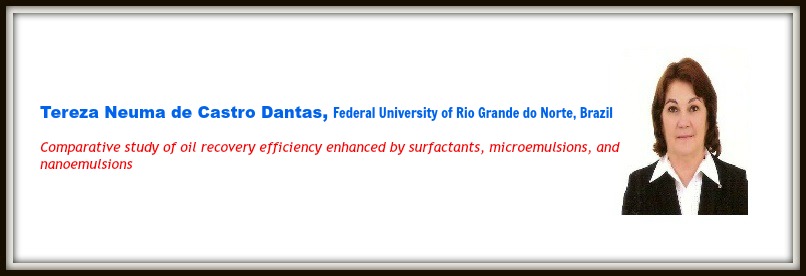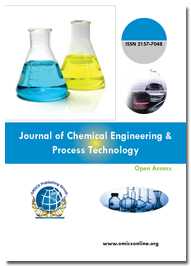Theme: Revealing the Innovations in Petrochemistry and Chemical Engineering
Petrochemistry 2015
OMICS Group Conferences invites all the participants across the globe to attend the "3rd World Congress on Petrochemistry and Chemical Engineering” (Petrochemistry 2015) slated on November 30-December 02, 2015 at Atlanta, USA.
Petrochemistry conference directs towards addressing main issues as well as future strategies of global energy industry. This is going to be the largest and most promising international conference where oil and gas industry professionals as well as decision makers will come to discuss and debate on various aspects of the challenges, risks and investment opportunities throughout the complete integrated energy and utilities supply chain. Petrochemistry International Conference will also provide the proper business opportunities and provide an in opportunity to make new decisions by meeting decision makes in the energy sector.
OMICS Group International is a pioneer and leading scientific event organizer, publishing around 500+ Open access journals and conducting over 1000+ Scientific Meetings all over the globe annually with the support of more than 1000 scientific associations, 30,000 editorial board members, and 3.5 million followers to its credit.
Chemical Applications in Producing Oil and Gas
Chemistry for Enhancing the Production of Oil and Gas provides an overview of the science and technology of the use of production chemicals to enhance and maintain oil and gas production. Geared towards a technically trained audience, this session emphasizes the technical aspects of the production management from the perspective of the upstream oil and gas industry.
The session describes the production environment and enhanced oil recovery meetings, problems that require chemical intervention, and thus, the need for the thousands of difference chemicals that are in use. It will review the important chemical and physical principles that are common to most, if not all, of the enhancement treatments. They also discuss aspects of the use and mechanisms of the complex chemistries that take place with the application of flow assurance chemicals, during stimulation (reactive chemistry and prop fracturing) and chemically improved oil recovery, including the use of chemical tracers. A final chapter emphasizes the importance of health, safety and environmental compliance in all aspects of oil refinery events.
Fuel Chemistry, Technology & Processing
Fuel Processing Technology covers the scientific and technological aspects of processing fuels and related wastes to other fuels, chemicals, and by-products as well as the analysis and characterization of process products. Petroleum processing is considered in the sense of chemical conversion, such as, hydrogenation, gasification, pyrolysis, bioconversion, and upgrading, as well as physical processing by beneficiation, cleaning and removal of inorganic matter. Coal, petroleum, natural gas, oil shale, tar sands, and organic wastes are emphasized. All technological aspects of processing are included, such as, optimization, catalysis, feeding, product separation and evaluation, catalyst recovery, economics, pollution control, etc., concerned with liquefaction, gasification, combustion, solvent extraction (or solvent refining) and the co-processing of coal/oil and coal/wastes, along with upgrading of conversion products such as O, N, or S removal. The fuel chemistry conferences invites research topics related to processing of fuels, products of processing & their experience in bench scale, process development units, pilot plants and commercial processes.
Petroleum geology is principally concerned with the evaluation of seven key elements in sedimentary basins: Source, reservoir, seal, trap, timing, maturation and migration. Petroleum geology focuses on exploration geosciences and develops key skills for understanding petroleum refinery process. It explains how to evaluate sedimentary basins and leads along with prospect generation, skills to explore for oil and gas (and unconventional hydrocarbons). Petroleum Geology Conference also provides a global overview of major hydrocarbon provinces, as well as current exploration trends.
Drilling & Well Completions Challenges
Drilling used to be hit or miss. In the energy industry's early days, operators hammered cable tools into the earth, hoping to find crude oil products or natural gas. But development of more sophisticated tools has enabled drillers to probe greater depths with more success in less time. Since the remaining hydrocarbons are more difficult to access, the search for oil and gas is constantly leading us into deeper waters and more remote terrain. Drilling and completions technologies have improved dramatically in recent years.
Completions technology also has evolved—installations are done in less time and reliably produce at greater rates. Cased-hole completion involves perforating the well casing and formation so that oil or gas can flow into production tubing. Open-hole completions are another option: Formations with weak rock often require sand screens and gravel packs to be inserted into the reservoir to stabilize the hole and maintain the flow of oil from the reservoir into the well bore. This process controls the migration of sand to avoid well failures and lost production. Next, acids and other fluids can be pumped into the well under high pressure to fracture, clean and stimulate the rock in order to increase our ability to produce oil or gas. Finally, production tubing is added to provide an efficient and safe flow to the surface. Petroleum Drilling meetings are also organized by the OMICS International to get awareness across the globe.
Upstream & Downstream Processes
The upstream sector includes the searching for potential underground or underwater crude oil and natural gas fields, drilling petroleum from exploratory wells, and subsequently drilling and operating the wells that recover and bring the crude oil and/or raw natural gas to the surface. There has been a significant shift toward including unconventional gas as a part of the upstream sector, and corresponding developments in liquefied natural gas (LNG) processing and transport.
The downstream sector commonly refers to the petroleum refining crude oil and the processing and purifying of raw natural gas, as well as the marketing and distribution of products derived from crude oil and natural gas. The downstream sector touches consumers through products such as gasoline or petrol, kerosene, hydrofuel, jet fuel, diesel oil, heating oil, fuel oils, lubricants, waxes, asphalt, natural gas, and liquefied petroleum gas (LPG) as well as hundreds of petrochemicals.
Upstream and Downstream meetings will be held at Petrochemistry Conference on November 30-December 02, 2015 at Atlanta, USA conducted by OMICS International.
Health and safety in the petrochemical industry is best tackled from two different perspectives: process safety and occupational health and safety. Process safety involves the prevention of leaks, spills, equipment malfunction, over-pressures, over-temperatures, corrosion, metal fatigue and other similar conditions. In the petrochemical industry, programmes of process safety should focus on design and engineering,training and maintenance of equipment. Effective process safety is the outcome or result of a wide range of technical, management and operational disciplines. Occupational safety includes Safety training, Safety in petroleum industries, Emergency chemical spill treatment, Safety culture, Commitment, Involvement, Competence, and Compliance.
A feedstock is defined as any renewable, biological material that can be used directly as a fuel, or converted to another form of fuel or energy product. Biomass feedstocks are the plant and algal materials used to derive fuels like ethanol, butanol, biodiesel and other hydrocarbon fuels which can be discussed at the global diesel meetings. Examples of biomass feedstocks include corn starch, sugarcane juice, crop residues such as corn stover and sugarcane bagasse, purpose-grown grass crops, and woody plants. Feedstock Organizations identify and develop economically, environmentally, and socially sustainable feedstocks for the production of energy, including transportation fuels, electrical power and heat, bioethanol,and other bio products. Efforts in this area will ultimately support the development of technologies that can provide a large and sustainable cellulosic biomass feedstock supply of acceptable quality and at a reasonable cost for use by the developing advanced biofuel industry.
Coal and Gas is the largest source of energy for the generation of electricity worldwide, as well as one of the largest worldwide anthropogenic sources of carbon dioxide releases. Coal is extracted from the ground by coal mining, either underground by shaft mining, or at ground level by open pit mining extraction. Coal gasification can be used to produce syngas, a mixture of carbon monoxide (CO) and hydrogen (H2) gas. Often syngas is used to fire gas turbines to produce electricity, but the versatility of syngas also allows it to be converted into transportation fuels, such as gasoline and diesel. It’s an immense pleasure to introduce the globe about Coal and Gas meetings at Petrochemistry 2015.
Natural gas currently accounts for nearly 52% of our hydrocarbon production, compared with 35% 10 years ago, exceeding our production of oil. Natural gas chain includes production to processing, transportation, trading, marketing and electricity generation in gas-fired power stations.
Natural gas can be liquefied, which gives it an additional advantage in that it is easy to transport over long distances by sea.
A colloid is a substance in which microscopically dispersed insoluble particles are suspended throughout another substance. Sometimes the dispersed substance alone is called the colloid. It includes the interaction of surfaces with fluids having molecular densities spanning the range from liquids to ultra-high vacuum. Among disciplines represented in the Division are physical chemistry, chemical physics, materials science, biochemistry, electrochemistry,petroleum chemistry, and chemical engineering.
Surface chemistry, study of chemical reactions in which the reactants are first adsorbed onto a surface medium that then acts as a catalyst for the reaction; after the reaction the products are desorbed and the surface is left unchanged.
Oil and Gas processing is a complex industrial refinery process — it is not simply a case of collecting it from the ground and channelling it into a pipeline ready for use by anyone switching on their cooker or fire. Raw material has to be cleaned by separating impurities and various non-methane hydrocarbons and fluids to produce pipeline quality product. Elements found in crude form include low molecular weight hydrocarbon compounds such as methane, ethane, propane and butane. The natural gas extracted from coal reservoirs and mines (coalbed methane) is the primary exception, being essentially a mix of mostly methane and about 10% carbon dioxide (CO2). The products obtained, should be separated.
Fluid Flow & Transfer Process in oil industry
In the Petroleum Industries, allocation refers to practices of breaking down measures of quantities of extracted hydrocarbons across various contributing sources. Allocation aids the attribution of ownerships of hydrocarbons as each contributing element to a commingled flow or to storage at petroleum companies may have a unique ownership. Contributing sources in this context are typically producing petroleum wells delivering flows of petroleum or flows of natural gas to a commingled flow or storage.
The terms hydrocarbon accounting and allocation are sometimes used interchangeably. Hydrocarbon accounting has a wider scope, taking advantages of allocation results, it is the petroleum industry management process by which ownership of extracted hydrocarbons is determined and tracked from a point of sale or discharge back to the point of extraction. In this way, hydrocarbon accounting also covers inventory control, material balance, and practices to trace ownership of hydrocarbons being transported in a transportation system, e.g. through pipelines to customers distant from the production plant.
In an allocation problem, contributing sources are more widely natural gas streams, fluid flows or multiphase flows derived from formations or zones in a well, from wells, and from fields, unitised production entities or production facilities.
Process Chemistry & Technology
The research within this cluster covers a broad spectrum in the field of chemical engineering sciences, from fundamental scientific understanding to targeted engineering applications. This approach positions the cluster at the cutting edge of academic research whilst retaining a high standard of industrial innovation. The major research areas in this cluster are: reactor and separation technology, process intensification and molecular heterogeneous catalysis. Combining these efforts across the length scales often leads to novel or improved reactor, separation and process concepts.
It includes:
Biofuels, Green Fuels, Carbon Capture, Chemicals & Petrochemicals, Gas Processing & Gas Treating, Gasification, Gas to Liquids/Chemicals, & IGCC, Heavy Oil Upgrading & Oil Sands, Hydrocarbon Transportation - Pipelines, Liquefied Natural Gas (LNG), Offshore Oil & Gas Production, Onshore Oil & Gas Production, Petroleum Refinery.
Chemical Reaction Engineering is a branch of Chemical Engineering which deals with chemical reactors. Generally catalytic reactions includes in Chemical Reaction Engineering. To understand Chemical Reaction Engineering we should have the knowledge of
1.Chemical kinetics
2.Chemical reaction equilibria
3.Mole balances
4. Thermochemistry
Now a days Chemical Engineering Conferences plays a vital role in chemical field as Researchers of Shell Amsterdam research center and the University of Delft started the concept of Chemical reaction engineering in 1956. J.C. Vlugter coined the term chemical reaction engineering.
Chemical reaction engineering points at examining and upgrading substance responses so as to characterize the best reactor outline. Thus, the communications of stream phenomena, mass exchange, heat exchange, and response energy are of prime imperativeness to identify reactor execution to sustain piece and working conditions. Despite the fact that initially connected to the petroleum refineries strikes and petrochemical businesses, its general system joining response science and substance building ideas permits to upgrade an assortment of frameworks where displaying or designing of responses is required. Chemical reaction engineering methodologies are without a doubt customized for the advancement of new procedures and the change of existing innovations.
Chemical reaction engineering can also be defined as usage of chemical reactions on commercial scale. It mainly deals with the effecting preparation, usage and working of chemical reactors. Petrochemistry 2015 plays a crucial role in organizing chemical health and safety meetings also.
Catalysis is the increase in the rate of a chemical reaction due to the participation of an additional substance called a catalyst. With a catalyst, reactions occur faster and with less energy. Because catalysts are not consumed, they are recycled. Often only tiny amounts are required. Catalysts work by providing an (alternative) mechanism involving a different transition state and lower activation energy. Consequently, more molecular collisions have the energy needed to reach the transition state.
Catalysts can be heterogeneous or homogeneous, depending on whether a catalyst exists in the same phase as the substrate. Biocatalysts (enzymes) are often seen as a separate group.
In order to ensure smooth and uninterrupted flow of oil and gas to the end users, it is imperative for the field operators, pipeline engineers, and designers to be corrosion conscious as the lines and their component fittings would undergo material degradations due to corrosion. This paper gives a comprehensive review of corrosion problems during oil and gas production and its mitigation. The chemistry of corrosion mechanism had been examined with the various types of corrosion and associated corroding agents in the oil gas industry. Factors affecting each of the various forms of corrosion were also presented. Ways of mitigating this menace with current technology of low costs had been discussed. It was noticed that the principles of corrosion must be understood in order to effectively select materials and to design, fabricate, and utilize metal structures for the optimum economic life of facilities and safety in oil and gas operations. Also, oil and gas materials last longer when both inhibitors and protective coatings are used together than when only batch inhibition was used. However, it is recommended that consultations with process, operations, materials, and corrosion engineers are necessary in the fitness of things to save billions of dollars wasted on corrosion in the oil and gas industries.
Oil industry holds a major potential of hazards for the environment, and may impact it at different levels: air, water, soil, and consequently all living beings on our planet. Within this context, the most widespread and dangerous consequence of oil and gas industry activities is pollution. Pollution is associated with virtually all activities throughout all stages of oil and gas production, from exploratory activities to Refining Crude. Wastewaters, gas emissions, solid waste and aerosols generated during drilling, production, refining (responsible for the most pollution) and transportation amount to over 800 different chemicals, among which, of course, prevail oil and petroleum products. Other environmental impacts include intensification of the greenhouse effect, acid rain, poorer water quality, groundwater contamination, among others. The oil and gas industry may also contribute to biodiversity loss as well as to the destruction of ecosystems that, in some cases, may be unique. In coming days OMICS International also wish to conduct solar energy conference, which plays a major role for the source of energy globally.
The futures market structure
The contango in the ICE Brent market structure widened slightly over the month amid slow demand and an oversupply of light, sweet grades in the Atlantic Basin. An overhang of Nigerian grades weighed on demand for competing sweet crude from the region. Moreover, North Sea crudes remained under pressure from the upcoming closure of the Forties very large crude carriers (VLCC) jetty at Hound Point, which will prevent any Forties from moving to the Asia Pacific region. A steady erosion in light distillate margins also undermined buying interest for sweet crudes. The ICE Brent first month discount to the second month increased by 15¢ to 90¢/b.
There by Petrochemistry meetings gives a wide range of knowledge to the people who attending the Petro chemistry 2015. Few of the eminent people who are attending the conference were conducting Petrochemistry symposiums at the conference venue.
Petrochemical Markets:
Petrochemical Markets provides detailed supply, demand and price forecasts of the key petrochemical feedstock naphtha along with an overview of the petrochemicals market including ethylene, propylene, benzene and paraxylene. The service also provides analysis on cracking economics, arbitrage economics, refinery and petrochemical facility turnarounds and their impacts on regional balance. Clients make confident decisions based on actionable insight from HIS Energy’s in-depth knowledge of market forces and political developments that drive petrochemical feedstock market combined with deep quantitative detail and extensive industry experience.
Petrochemical Market analysis:
Petrochemicals are an essential part of commodities used in daily lives. They are used in various end-use industries, ranging from manufacturing to consumer goods. Petrochemicals are chemical compounds derived from petroleum and other hydrocarbons, which are obtained from crude oil and natural gas. They are primarily used as chemical building blocks for a variety of materials and applications. Rising demand for petrochemicals in major end-use industries coupled with favourable operating conditions, primarily in the Middle East and Asia Pacific, is expected to drive the global market for petrochemicals from 2013 to 2030. Demand for bio-based chemicals is increasing due to growing consumer awareness and benefits associated with their usage. Investment in bio-based chemicals in the public sector (including national laboratories and universities) and commercial sector (including large multinational corporations) is anticipated to increase in the near future. Therefore, this trend is estimated to hamper the petrochemicals market. Additionally, volatility in prices of crude oil & natural gas is likely to inhibit market growth. However, rising shale gas discoveries, primarily in North America (including the U.S. and Canada) is benefitting petrochemical producers, since shale gas is considered a substitute feedstock that is used in the manufacture of petrochemicals.
The report provides analysis and forecast for the global petrochemicals market in terms of volume (million tons) and revenue (US$ Bn) from 2013 to 2020. The study segments the market based on product type into ethylene, propylene, butadiene, benzene, xylene, toluene, vinyls, styrene and methanol. The report further analyzes each product type based on their application and region from 2013 to 2030. The report also includes estimates and forecast of demand for petrochemicals in major geographical regions including North America, Europe, China, Rest of Asia Pacific, the Middle East & Africa, and Latin America. The market size and forecast for each region has been provided for the period from 2013 to 2020 along with the CAGR (%) for the forecast period between 2014 and 2020. All product segments are forecast for the period from 2013 to 2020 in terms of volume (million tons) and revenue (US$ Bn).
The report also comprises a detailed value chain analysis that offers a comprehensive view of value addition at each stage of the value chain. The value chain of petrochemical is significantly integrated, both from the downstream and the upstream perspective. It is dominated by refineries that process raw crude oil, natural gas and coal to manufacture olefins and aromatics through fluid catalytic cracking of petroleum fractions. The study includes Porter’s Five Forces model, which analyzes the existing competition, bargaining power of suppliers, bargaining power of buyers, threat from substitutes, and threat from new entrants. The report includes drivers and restraints affecting the growth of the petrochemicals market, and the impact of these factors on the market in the near future. Additionally, it provides opportunities for the petrochemicals market on the global level during the forecast period. The report also includes market shares of major companies operating in the global petrochemicals market. It also provides market attractiveness of petrochemicals. The market attractiveness analysis is based on various factors such as market size of each product, growth rate during the forecast period, demand for downstream products, and government and environmental regulations.
The report comprises company profiles of major players in the market. These profiles cover parameters such as company overview, product portfolio, financial overview, business strategies, and recent developments. Major players analyzed in the report include BASF SE, ExxonMobil, The Dow Chemical Company, Shell Chemical Company, SABIC, Sinopec Limited, LyondellBasell Industries, Total S.A., Sumitomo Chemical Co. Ltd., Chevron Phillips Chemical Company LLC and E. I. du Pont de Nemours and Company.
This report segments the global petrochemicals market as follows:
-
Petrochemicals Market: Product Segment Analysis
- Ethylene
- Propylene
- Polypropylene
- Propylene oxide
- Acrylonitrile
- Cumene
- Acrylic acid
- Isopropanol
- Other (Including Polygas chemicals and oxo-chemicals)
- Styrene-butadiene rubber
- Butadiene rubber
- Acrylonitrile butadiene styrene
- Styrene-butadiene latex
- Other (Including Nitrile rubber and mechanical belts)
- Ethyl benzene
- Cumene
- Cyclohexane
- Nitrobenzene
- Alkyl benzene
- Other (Including Maleic anhydride)
- Butadiene
- Benzene
- Xylenes
- Solvents
- Toluene diisocyanate
- Other (Including Pesticides, drugs and nitrotoluene)
- Benzene
- Polystyrene
- Expandable polystyrene
- Acrylonitrile butadiene styrene
- Styrene-butadiene latex
- Unsaturated polyester resins
- Styrene-butadiene rubber
- Other (Including copolymer resins)
- Formaldehyde
- Gasoline
- Acetic acid
- Methyl Tertiary Butyl Ether (MTBE)
- Dimethyl ether
- Methanol to olefins (MTO)
- Other (Including biodiesel, solvent and chloromethane)
- Xylene
- Toluene
- Vinyls
- Styrene
- Methanol
-
Petrochemicals Market: Regional Analysis
- North America
- Europe
- China
- Rest of Asia Pacific
- Middle East & Africa
- Latin America
- Petrochemicals are widely used in various end-use industries such as construction, automobile and packaging. Hence, growth in these end-use industries is one of the major factors driving the global petrochemicals market. Abundant availability of raw materials in the Middle East - the region is one of the largest producers and exporters of crude oil and natural gas in the world - is another factor boosting the petrochemicals market. Government initiatives in India and China for establishing petrochemical complexes are also expected to drive the market for petrochemicals. However, shift towards bio-based chemicals coupled with environmental issues arising due to usage of various petrochemicals is projected to hamper market growth during the forecast period.
- Ethylene was the leading petrochemical product, accounting for over 25% of the global petrochemicals market in 2013. Ethylene was followed by propylene, which is primarily used in the manufacture of polypropylene and propylene oxide. Methanol is projected to be the fastest growing segment from 2014 to 2020. Growth of methanol is directly related to its increasing usage in gasoline blending and methanol to olefins (MTO) processes. Other petrochemicals such as butadiene, benzene, xylene, toluene, vinyls and styrene accounted for a significant portion of the global petrochemicals market share in 2013.
- The global market for petrochemicals is highly fragmented in nature. It is dominated by top multinational corporations that operate across the value chain. Major players in the petrochemicals industry include BASF SE, ExxonMobil, The Dow Chemical Company, Shell Chemical Company, SABIC, Sinopec Limited, LyondellBasell Industries, Total S.A., Sumitomo Chemical Co. Ltd., Chevron Phillips Chemical Company LLC and E. I. du Pont de Nemours and Company.
Snapshot of American Petrochemical Market:
Oil prices imploded in 2015, and experts say they will decline further before recovering later in 2016. The drop is a challenge to the natural-gas-based petrochemical industry in the U.S., but producers should remain competitive versus the rest of the world.
After hitting a peak of more than $105 per barrel last June, oil prices dropped below $60 in December. Oversupply in the marketplace is running 700,000 bbl ahead of global demand of about 92 million bbl per day, according to the Energy Information Administration. This overhang, EIA says, will persist through the middle of the year, putting downward pressure on prices.
That’s good news for chemical companies in Asia and Europe, which make ethylene primarily from oil-based naphtha. Most U.S. chemical makers crack natural-gas-derived ethane, which has been cheap since the shale gas boom began late last decade. But now the oil price decline is pinching their cost advantage.
For example, high-cost Asian producers set global prices for petrochemical derivatives such as polyethylene, notes Dewey Johnson, senior director of market research for IHS Chemical. Lower oil prices are starting to push those prices down.
However, strong demand at home might mute the impact for U.S. companies. “I don’t think it is a given that the U.S. matches Asian movement,” Johnson says. “I would expect there will be reduced margins for U.S. producers—but still very favorable margins.”
Sergey Vasnetsov, head of strategic planning and transactions at LyondellBasell Industries, made a similar assessment before an investor conference last month. It costs between 10 and 15 cents to make a pound of ethylene in a U.S. ethane cracker, he said, and 40 to 60 cents to do so in naphtha crackers elsewhere. Lower oil prices might bring costs for naphtha crackers down somewhat, but not to North American levels.
And the economic effect of lower oil prices should be beneficial, Vasnetsov pointed out, citing a rule of thumb that the global economy gets a 0.2% lift in annual growth and a 0.5% reduction in inflation for every $15 decline in oil prices.
Top 15 largest world oil companies by reserves and production are Saudi Aramco, NIOC, Qatar Petroleum, ExxonMobil, PetroChina, PDVSA, BP, ADNOC, Royal Dutch Shell, Pemex, NNPC, Chevron, NOC, Kuwait Petroleum Corporation, Sonatrach.
International companies that have a market share in upstream sector are:
· BG Group
· BHP Billiton
· ConocoPhillips
· Chevron
· Eni
· ExxonMobil
· OMV
· Hess Ltd
· Marathon Oil
· Total
· Tullow Oil
· First Texas Energy Corp
The midstream sector is dominated by a number of companies that specialize in gathering, processing, transportation, storage and technological application services. Midstream companies include:
· Aux Sable
· Bridger Group
· DCP Midstream
· Enbridge Energy Partners
· Enterprise Products Partners
· Genesis Energy
· Gibson Energy
· Inergy Midstream
· Kinder Morgan Energy Partners
· Oneok Partners
· Plains All American
· Sunoco Logistics
· Targa Midstream Services
· TransCanada
· Williams Companies
Petroleum (crude oil) exploration and production companies: There are around 200 companies globally with 45 companies in North America, 12 companies in Africa, 54 companies in Asia, 63 companies in Europe, 6 companies in Oceania, and 13 companies in South America.
Major Oil and Gas Companies in America:
Top 10 U.S. oil and gas companies based on market value in 2015 (in billion U.S. dollars)
This statistic shows the top 10 U.S. oil and gas companies based on market value in 2015. The values are based on the Financial Times Global 500 list. As of March 2015, U.S. oil and gas company Chevron reached a market value of some 227 billion U.S. dollars.
Top U.S. oil and gas companies
The oil and gas industry is one of the largest industries worldwide. This sector is involved in exploration, extraction, refining, transport and marketing of these commodities. Many industries are extremely dependent on oil and gas products, mostly in the form of energy fuels or raw materials for chemical products.
Oil and gas companies from the United States are among the world’s largest corporations. For example, ExxonMobil, Conoco Phillips and Chevron are long on top globally based on revenue. Periodically, ExxonMobil was the world’s largest company in general, with revenues exceeding by far the mark of 400 billion U.S. dollars. As of March 2015, it was also the company with the highest market capitalization, only topped by technology giant Apple. Most of the top U.S. oil and gas companies are involved all over the world, generating large portions of their incomes outside the United States.
The United States has a long tradition of oil and gas companies. ExxonMobil, for example, is a direct descendent of Rockefeller’s Standard Oil Company, which was founded in 1870. Chevron has its roots in the Pacific Coast Oil Company, founded in 1879.

Market value in billion U.S dollars.
Top 10 Universities which offer Petroleum Engineering:
- Texas A&M University
- University of Adelaide
- University of New South Wales
- Colorado School of Mines
- University of Manchester
- University of Texas
- The University of Stavanger
- Curtin University
- Universiti Teknologi Petronas
- Heriot-Watt University
Global Petroleum Associations:
- American Association of Petroleum Geologists
- American Institute of Mining, Metallurgical, and Petroleum Engineers
- Australian Institute of Petroleum
- Australian Petroleum Production and Exploration Association
- Canadian Association of Oil well Drilling Contractors
- Canadian Association Of Petroleum Producers
- Canadian Heavy Oil Association
- Canadian Institute of Mining, Metallurgy and Petroleum
- Canadian Society of Petroleum Geologists
- Denver Region Exploration Geologists' Society
- Independent Petroleum Association of America
- Japanese Association for Petroleum Technology
Professional and Industry Associations in America:
- The Society of Petroleum Engineers (SPE)
- American Association of Petroleum Geologists
- American Association of Drilling Engineers
- American Institute of Chemical Engineers
- Council of Petroleum Accountants Societies
- Society of Petroleum Engineers
- American Association of Professional Landmen
Why Atlanta?
In Atlanta there are more than 45 Petroleum companies and around 1.2 million people are working and researching on Petroleum. Major petroleum companies in Georgia State are: Mansfield Energy, Atlanta Petroleum, Akins Petroleum Company, Amicalola Propane, B P Amoco Marketer's Association, Barrow Propane Gas Inc, Blue Flame Gas Company, City of Tifton Natural Gas Sys, Colonial Group Inc, Dilmar Oil Company, Dixie Gas & Oil Corporation, Fletcher Oil, Gas South, Lewis & Raulerson Inc, May & Carter Oil Company, South Star, Strickland Oil Company and Tugalo Gas Company.
Why to attend???
With members from around the world focused on learning about Petroleum and Refinery; this is your single best opportunity to reach the largest assemblage of participants from the global petroleum sector. Conduct demonstrations, distribute information, meet with current and potential customers, make a splash with a new product line, and receive name recognition at this 3-day event.
World-renowned speakers, the most recent techniques, tactics, and the newest updates in the field of petroleum and refinery are hallmarks of this conference.
To share your views and research, please click here to register for the Conference.
To Collaborate Scientific Professionals around the World
| Conference Date | November 29-30,2015 | ||
| Sponsors & Exhibitors |
|
||
| Speaker Opportunity Closed | Day 1 | Day 2 | Day 3 |
| Poster Opportunity Closed | Click Here to View | ||
Useful Links
Special Issues
All accepted abstracts will be published in respective Our International Journals.
- Journal of Petroleum & Environmental Biotechnology
- Journal of Chemical Engineering & Process Technology
- Journal of Advanced Chemical Engineering
Abstracts will be provided with Digital Object Identifier by




























